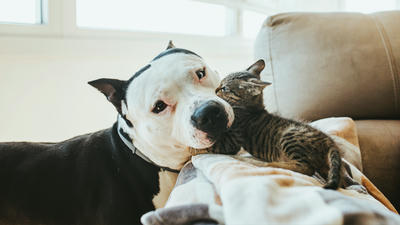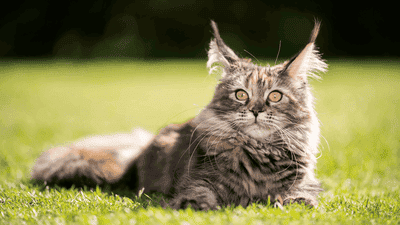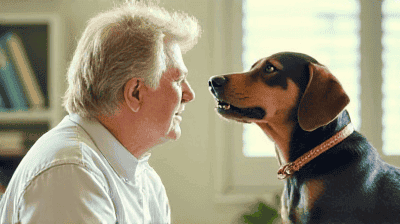Managing Multi-Pet Households: Keeping the Peace at Home

Owning multiple pets can bring immense joy and companionship into our lives. However, it also presents unique challenges when it comes to maintaining harmony in the household. Whether you have dogs, cats, birds, or a combination of different animals, managing a multi-pet household requires careful planning, understanding, and patience.
Understanding the Dynamics of Multi-Pet Households
The Benefits of Having Multiple Pets
Before diving into the management strategies, it's essential to recognize the benefits of having multiple pets:
Companionship: Pets can provide companionship not only to their human owners but also to each other, which can reduce loneliness and anxiety.
Socialization: Having pets that interact with one another can improve their social skills, helping them learn to communicate and coexist effectively.
Emotional Support: Pets often provide emotional support to one another, especially during stressful times or transitions.
Shared Playtime: Pets can entertain each other, reducing the burden on owners to provide constant stimulation.
The Challenges of Multi-Pet Households
While the benefits are significant, there are also challenges to consider:
Resource Competition: Multiple pets can lead to competition for food, toys, and attention, creating tension and potential conflicts.
Behavioral Issues: Differences in personalities and temperaments can lead to aggression or fearful behaviors among pets if not managed correctly.
Space Constraints: Limited space can exacerbate territorial behavior and stress in pets, especially in smaller homes or apartments.
Increased Care Responsibilities: Caring for multiple pets requires more time, effort, and resources compared to a single pet.
Preparing for a Multi-Pet Household

1. Assessing Compatibility
Before bringing a new pet into your home, assess their compatibility with your existing pets:
Temperament: Consider the temperaments of your current and prospective pets. Are they assertive or timid? Social or more reserved?
Species Considerations: Different species of pets have unique needs and behaviors. For example, dogs and cats have distinct social hierarchies and communication styles.
Age and Activity Levels: Ensure that the activity levels and ages of potential pets align. For example, a senior pet may not be compatible with an energetic puppy.
2. Introducing New Pets
When introducing a new pet to your household, follow these steps to ensure a smooth transition:
Gradual Introductions: Allow pets to get acclimated to each other's scents before direct interactions. Consider using blankets or toys that carry the scent of the new pet.
Controlled Meetings: Use a controlled environment for initial introductions, such as keeping pets on leashes or in separate rooms. Observe their reactions and interactions.
Supervised Interactions: Gradually increase the time they spend together while supervising closely to prevent any aggressive or fearful behavior from escalating.
Establishing a Routine
1. Feeding Schedules
Creating structured feeding times can reduce competition and anxiety around food:
Separate Feeding Areas: Designate specific feeding areas for each pet to prevent resource guarding. Use barriers or different rooms if necessary.
Consistent Schedule: Feed pets at the same times each day to establish routine. This consistency helps pets anticipate meal times without stress.
2. Exercise and Playtime
Regular exercise and playtime are essential for maintaining peace in a multi-pet household:
Individual Attention: Schedule daily individual playtime for each pet. This not only strengthens your bond but also reduces jealousy.
Group Activities: Organize group play sessions with toys that can accommodate multiple pets, such as tug ropes or interactive games. Always monitor their interactions.
3. Training Routines
Establishing training routines ensures that all pets understand expected behaviors:
Training Commands: Teach basic commands and reinforce positive behavior with treats and praise. Consistent training helps minimize conflicts.
Socialization: Gradually expose pets to various environments, people, and other animals. Well-socialized pets are less likely to develop behavioral problems.
Individualizing Care for Each Pet

1. Understanding Unique Needs
Each pet has unique behavioral and physical needs that must be acknowledged and nurtured:
Health Care: Keep track of each pet’s medical history, including vaccinations, check-ups, and any specific health concerns.
Behavioral Needs: Identify and understand each pet's temperament, preferences, and trigger points.
2. Creating Safe Spaces
Providing safe spaces for each pet is essential for their comfort:
Quiet Zones: Designate specific areas in your home where pets can retreat to feel safe and secure. These might include a cozy bed or a separate room.
Personal Spaces: Offer personal items or toys for each pet, helping them feel secure in their territory.
3. Monitoring Interactions
Fostering positive relationships among pets involves consistent observation:
Watch for Stress Signals: Be vigilant for signs of stress, such as growling, barking, or hissing. Addressing these behaviors early can prevent escalation.
Rotate Activities: If conflicts arise, consider rotating pets in and out of play or socialization sessions to reduce tension.
Managing Behavioral Issues
1. Addressing Aggression and Fear
Behavioral issues can arise in multi-pet households, particularly aggression or fear responses:
Identify Triggers: Take note of specific triggers that provoke aggressive behavior. This awareness can help you mitigate future incidents.
Use Positive Reinforcement: Reinforce positive behaviors through treats and praise rather than punishment. Positive reinforcement encourages desired actions.
2. Seeking Professional Help
When facing persistent behavioral problems, involving a professional can be beneficial:
Consult a Veterinarian: A veterinarian can rule out underlying health issues that may contribute to behavioral problems.
Hire a Pet Behaviorist: A certified pet behaviorist can offer customized strategies to address specific challenges within your multi-pet household.
Building a Bond Among Pets

1. Group Activities
Encourage bonding through group activities and interactions:
Pack Walks: Take all your pets for group walks. This can facilitate bonding as pets socialize in a controlled, shared experience.
Playdates with Trusted Friends: Organize playdates with well-socialized pets to strengthen your pets' social skills and comfort with other animals.
2. Shared Experiences
Creating shared experiences can foster relationships:
Training Together: Have group training sessions where pets learn together. This encourages bonding while teaching important behaviors.
Field Trips: Take pets on outings, whether to a pet-friendly park, beach, or café, providing them with enriching experiences.
3. Celebrating Together
Mark special occasions together to reinforce family bonds:
Birthdays and Milestones: Celebrate your pets’ birthdays with treats, toys, or even a small gathering. Involve all pets in the festivities.
Positive Reinforcement Days: Consider designating a day for rewarding positive behavior among your pets. This can strengthen collective experiences.
Ensuring Health and Wellness in Multi-Pet Households
1. Regular Veterinary Care
Regular medical check-ups are essential for maintaining overall health:
Group Appointments: Consider scheduling veterinary visits for multiple pets on the same day, if possible, to maintain preventive care.
Vaccination Records: Keep accurate records of vaccinations and any health issues. This is crucial for tracking wellness.
2. Preventing the Spread of Illness
Multi-pet households can pose risks for the spread of illness:
Isolation When Necessary: If one pet becomes ill, isolate them to prevent transmission of illness among the other pets.
Hygiene Practices: Maintain good hygiene practices, such as cleaning litter boxes, washing bowls, and disinfecting common areas regularly.
3. Nutritional Needs
Each pet has specific dietary needs, and meeting those is crucial:
Consult a Veterinarian: Work with your veterinarian to determine appropriate diets for each pet based on their health, age, and activity level.
Monitor Feeding: Ensure each pet receives their appropriate portion and prevent stealing by feeding pets separately if necessary.
Establishing a Multi-Pet Household Environment
1. Space Considerations
Creating a pet-friendly environment involves thoughtful space management:
Defined Areas: Designate specific areas for each pet’s bed, food, and toys to help reduce competition over resources.
Vertical Space for Cats: Enhance your home by incorporating vertical spaces, such as cat trees or shelves, for cats to explore and feel at ease.
2. Safety Measures
Safety should be paramount in a multi-pet household:
Secure Hazardous Items: Ensure all hazardous items, chemicals, and small objects are securely stored away from pet reach.
Non-Toxic Plants: Carefully select houseplants that are non-toxic to your pet, avoiding exposure to potentially harmful flora.
3. Create Enriching Environments
Both physical and mental stimulation are important:
Interactive Toys: Use a variety of interactive toys to keep all pets engaged, offering different challenges based on their preferences.
Environmental Enrichment: Rotate toys and introduce new challenges regularly to prevent boredom and stimulate curiosity.
Accommodating Different Species
If your multi-pet household includes different species, special considerations apply:
1. Dogs and Cats Living Together
When dogs and cats coexist, emphasize training and management:
Introduce Gradually: Begin introductions slowly, using barriers like gates to maintain distance at first and gradually allowing supervised interactions.
Supervised Interactions: Monitor all interactions, as dogs often have stronger prey drives and may not be aware of their impact on cats.
2. Birds and Other Pets
Integrating birds with other pets requires diligent oversight:
Separate Areas: Ensure birds have a secure space away from other pets to prevent stress or potential harm.
Careful Introductions: Observe behaviors carefully when introducing birds to other pets. Always prioritize the safety and comfort of the birds.
3. Small Animals and Larger Pets
If you have small animals (like rabbits, guinea pigs, or hamsters), extreme caution is necessary around larger pets:
Secure Housing: Use appropriate cages and enclosures for small animals to ensure they are safe from larger pets’ curiosity.
Harmonious Living: Teach larger pets to respect the boundaries of smaller ones, increasing the likelihood of harmonious coexistence.
Communication and Understanding
1. Reading Pet Body Language
Understanding your pets' body language can help prevent conflicts:
Recognizing Signals: Learn to identify signs of discomfort, stress, or aggression in your pets. This awareness allows for proactive solutions.
Responding Appropriately: React calmly to your pets’ cues. If one pet appears tense or fearful, intervene in a way that respects their space and needs.
2. Training for Better Communication
Training is vital for ensuring everyone knows how to coexist peacefully:
Teach Commands: Command training can help pet owners communicate expectations clearly, teaching pets to respond more effectively.
Reinforce Positive Behavior: Use positive reinforcement to encourage desired behaviors, instilling a sense of respect and understanding among pets.
Handling Conflicts
1. Conflict Resolution Strategies
Inevitably, conflicts may arise in a multi-pet household. Here’s how to address them:
Separate Immediately: If a conflict occurs, separate the pets immediately to allow for cooling down. Use calming techniques if necessary.
Evaluate Triggers: Analyze what provoked the conflict and consider how to modify the environment or routine to prevent recurrence.
2. Encouraging Positive Interactions
Focus on building positive interactions among pets over time:
Reward Peaceful Moments: Whenever pets are calm around each other, offer praise and rewards to condition positive associations.
Playtime Supervision: Always supervise playtime initially, intervening promptly to redirect negative behaviors or conflicts.
Final Thoughts
Managing a multi-pet household requires effort, patience, and understanding. By recognizing the unique needs of each pet and establishing a caring, structured environment, you can foster a peaceful coexistence among your pets.
With thoughtful preparation, consistent routines, and effective communication strategies, your home can be a harmonious space where all your furry, feathered, or scaly friends feel loved, secure, and fulfilled. Remember that it is a journey, and the bonds you create with your pets will be enriching for both you and them.








